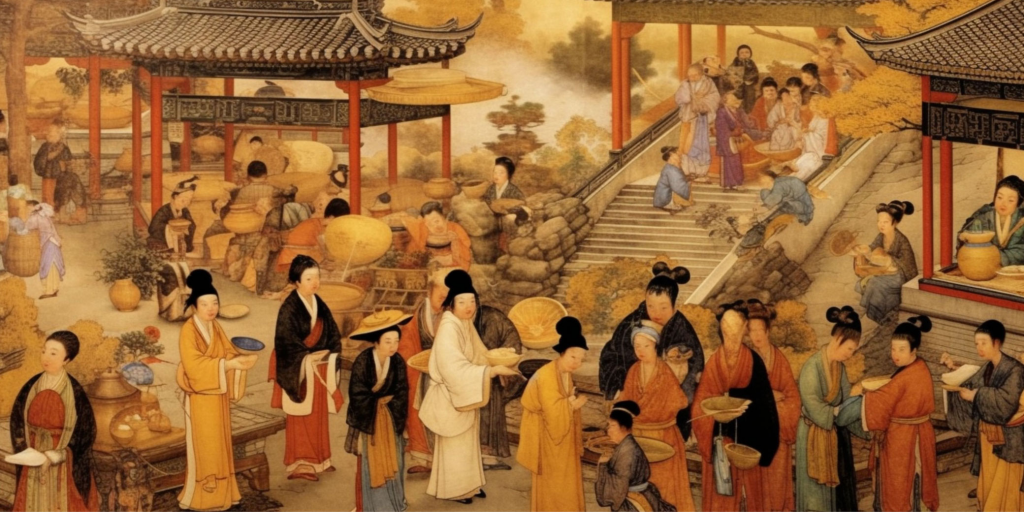When people think about ancient China’s marriage customs, the image of a wealthy man surrounded by multiple wives and concubines often comes to mind. Many romanticize this as a life of pleasure, but the truth is far from idyllic. The system of yī fū yī qī duō qiè (one husband, one wife, multiple concubines) was not designed for love—it was a carefully crafted mechanism to maintain lineage and property inheritance. In reality, concubines were little more than tools for their masters and the legal wives, with no personal rights, no autonomy, and often no recognition as full members of the family.

Concubines: Playthings, Surrogates, and Disposable Assets
The difference between a wife and a concubine in ancient China was stark. The wife (zhèngqī) was the legally recognized matriarch of the family, while concubines (qiè) were essentially lesser beings, existing solely to serve the family’s interests. The classic novel Dream of the Red Chamber (Hóng Lóu Mèng) illustrates this vividly: the character Tanchun, born to a concubine, had to refer to her father’s wife as “mother,” while her actual birth mother, Lady Zhao, had no authority over her own child.
The law reinforced this rigid hierarchy. The Tang Code (Táng Lǜ Shū Yì) strictly prohibited treating a concubine as a wife—any man who attempted to do so would face imprisonment for 18 months, followed by forced labor. Concubines had no legal standing, no inheritance rights, and no ability to challenge their status. Even their children were legally under the control of the main wife, not their birth mother. In essence, concubines were nothing more than walking wombs, their worth measured by their ability to produce sons.
The Cruel Incentive for Wives to Accept Concubines
It might seem strange that legal wives tolerated the presence of concubines. The reason was survival. In ancient China, a woman’s worth was tied to her ability to produce a son. Without one, she was at risk of being discarded or, worse, having her property seized by her husband’s clan in a brutal practice known as chī jué hù—“eating the widow’s inheritance.”
A tragic example is Wu Zetian’s mother, Lady Yang. Despite being from a noble family, she was left homeless with her daughters after her husband died, simply because she had no sons. To avoid this fate, many wives actively sought out concubines for their husbands, hoping that a concubine’s son could be legally adopted as their own, securing their place in the household. Under Tang law, if a wife reached the age of 50 without a son, the husband’s illegitimate children could be legally recognized as heirs. This meant that the wife’s best bet for security was to claim the children of concubines as her own, rather than resisting them.
Concubines Were Barely Better Than Servants
Some people imagine that being a concubine was an enviable position, but historical records suggest otherwise. Most concubines came from poor families, and many were even classified as jiànmín—low-born individuals with no legal rights. In practice, concubines could be bought, sold, gifted, or even executed at the master’s whim.
One infamous example comes from the Ming Dynasty novel Jīn Píng Méi, where the concubine Pan Jinlian was repeatedly humiliated by the legal wife and ultimately murdered without consequence. Similarly, in The Story of a Noble Couple Awakening to the Harsh Reality of Marriage (Xǐng Shì Yīnyuán Zhuàn), a wife coldly tells a concubine, “If you bear a son, I’ll personally serve you tea; if not, you’d better leave.” This wasn’t jealousy—it was calculation. Concubines were tolerated only as long as they were useful.
The Harsh Reality for Ordinary Men: No Women, Just War and Labor
While some men dream of time-traveling to ancient China for the chance to live like a feudal lord, the reality is that most would not have been masters of a grand household. In fact, most men would have struggled to even find a wife.
With a high rate of female infanticide, frequent wars, and the concentration of women in the harems of the elite, the gender ratio was severely imbalanced. Many men remained unmarried, and their fate was often grim. The poem The Officer at Stone Moat Village (Shí Háo Lì) by Du Fu paints a bleak picture of conscription, where an old woman laments that all her sons have been taken for war, leaving only a baby behind.
Even in peacetime, men were drafted for backbreaking labor projects like the Grand Canal. The Sui Dynasty’s construction efforts alone claimed the lives of hundreds of thousands of men. One historical account states that of a million workers, “half perished.” If a man somehow survived all this, he still faced crushing poverty and an almost nonexistent chance of social mobility.
Polygamy Was a System of Oppression for Everyone
The institution of polygamy did not just harm women—it was a tool that reinforced the dominance of the elite over both genders. The majority of men were left without wives, while the majority of women were reduced to property. The only winners were the ruling class, who accumulated power, wealth, and concubines.
Today, modern monogamy benefits not just women but also ordinary men. Unlike in feudal times, the average man does not have to compete with the ultra-rich for a wife, nor does he face the prospect of forced labor or military conscription. The polygamous past was not a paradise—it was a nightmare for all but a select few.

No comments yet.